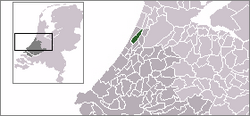Noordwijkerhout
 flag |
 coat of arms |
| province |
|
| local community |
|
|
Area - land - water |
23.42 km 2 22.59 km 2 0.83 km 2 |
| Residents | 16,742 (Sep 30, 2018) |
| Coordinates | 52 ° 16 ′ N , 4 ° 30 ′ E |
| Important traffic route |
|
| prefix | 0252 |
| Postcodes | 2191, 2211-2212 |
| Website | Homepage of Noordwijkerhout |
Noordwijkerhout ( ) was a municipality in the Dutch province of South Holland and, according to the CBS, had 16,742 inhabitants on September 30, 2018 . Their total area was 23.42 km².
places
- Noordwijkerhout (about 13,000 inhabitants), where the municipal administration was located
- De Zilk (about 2100 inhabitants)
Location and economy
Noordwijkerhout, like its eastern neighbor Lisse , is about halfway between Haarlem and Leiden (each about 13 km away). It lies between mostly excavated dunes , just northeast of the North Sea resort of Noordwijk . Rail travelers can get there by bus from Leiden.
Noordwijkerhout is located in the Bollenstreek , the region of flower bulb growers . This type of horticulture with the related tourism is the main source of income for the residents. The psychiatric hospitals and the convention center in the community are also important for the economy.
history
The area was settled about 2000 years ago by the Caninefaten or Cananefaten, a Germanic tribe. In 889, according to a document, there was an area here called Northgo (Nordgau). The village developed around a hunting lodge owned by local gentlemen. In 1262 the abbey " Leeuwenhorst " was founded here, which was demolished in 1573 after the Reformation . Later there was a temporary lock in its place. From 1434 Noordwijkerhout Main location was one of a so-called "Baljuw" ( Amtmann managed) glory; it had the “high judiciary”, which means that the Baljuw had the death sentences carried out here. Lisse and Hillegom also belonged to this area . Until the late 19th century the population lived poorly on agriculture , fishing, extracting lime from dune sand, etc. In the 20th century, parts of the dunes were excavated to make way for tulip fields. The cultivation of flower bulbs brought significant wealth. In 1970 the Pastoral Council ( Pastoraal Concilie van de Nederlandse Kerkprovincie ) of the Roman Catholic Church in the Netherlands met in Noordwijkerhout .
Worth seeing or remarkable
- The Leeuwenhorst International Congress Center , a former monastery , is one of the most important in the Netherlands
- The tulip fields
- The white church in the middle of the village
- The town hall
Noordwijkerhout's town hall is a listed building ( Rijksmonument ). The building was built in 1930 based on a design by architect Kropholler from Wassenaar. In 1956 the town hall was expanded in the same style. When a further extension was necessary in 1982, an extension was created to accommodate the library.
In addition to the town hall, many more monumental buildings can be seen in the municipality; the white church in the center of Noordwijkerhout, the main building of the former psychiatric clinic St. Bavo, the Noordwijkerhouter churches St. Victor and St. Jozef and the Heilig Hart church in De Zilk. Noordwijkerhout is also home to the Vakantiehuis De Vonk building , which was built in 1919 under the direction of the architect Theo van Doesburg . There are also stained glass windows by the artist Harm Kamerlingh Onnes to see.
The municipality also has six state monuments and a few dozen buildings in the center and in the countryside that would be worth a monument.
Art objects have been set up in various places in the municipality of Noordwijkerhout. The sculptures by the artist couple Frans and Truus van der Veld form a special trinity. The main source of inspiration comes from the love for the bulb trade for which the municipality of Noordwijkerhout is known.
politics
fusion
On July 6, 2017 it was decided to incorporate Noordwijkerhout into Noordwijk on January 1, 2019.
Distribution of seats in the municipal council
The local elections on March 19, 2014 resulted in the following distribution of seats:
| Political party | Seats | |||
|---|---|---|---|---|
| 2002 | 2006 | 2010 | 2014 | |
| VVD | 6th | 6th | 6th | 4th |
| NZLokaal | - | - | - | 5 |
| CDA | 6th | 5 | 5 | 4th |
| D66 | 1 | 1 | 2 | 2 |
| GroenLinks | 2 | 2 | 2 | 1 |
| PvdA | 2 | 3 | 2 | 1 |
| total | 17th | 17th | 17th | 17th |
Due to the merger on January 1, 2019, the elections for the council of the (new) municipality took place on November 21, 2018.
mayor
Gerrit Goedhart ( CDA ) was the acting mayor of the municipality from December 1, 2005 until the municipality was dissolved . His colleagues included the councilors Bert Gotink ( D66 ), Henri de Jong (CDA), Martijn Bilars ( VVD ) and the community secretary Theo Heijsteeg .
Web links
Individual evidence
- ↑ Bevolkingsontwikkeling; regio per maand . In: StatLine . Centraal Bureau voor de Statistiek , accessed January 1, 2019 (Dutch)
- ↑ Fusie Noordwijkerhout - Noordwijk Gemeente Noordwijkerhout, accessed on June 8, 2018 (Dutch)
- ↑ Result of the local elections: 2010 2014 , accessed on June 8, 2018 (Dutch)
- ↑ Allocation of seats in the municipal council: 2002 2006 2010 2014 , accessed on June 8, 2018 (Dutch)
- ↑ Herindelingen Kiesraad , accessed on May 30, 2018 (Dutch)
- ↑ Burgemeester Goedhart voorgedragen voor herbenoeming. In: Bollenstreek Omroep. July 6, 2017, accessed June 8, 2018 (Dutch).
- ↑ Samenstelling Gemeente Noordwijkerhout, accessed on June 8, 2018 (Dutch)

